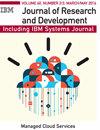Heterogeneous integration for artificial intelligence: Challenges and opportunities
IF 1.3
4区 计算机科学
Q1 Computer Science
引用次数: 11
Abstract
The recent progress in artificial intelligence (AI) and machine learning (ML) has enabled computing platforms to solve highly complex difficult problems in computer vision, robotics, finance, security, and science. The algorithmic progress in AI/ML have motivated new research in hardware accelerators. The dedicated accelerators promise high energy efficiency compared to software solutions using CPU. However, as AI/ML models become complex, the increasing memory demands and, hence, high energy/time cost of communication between logic and memory possess a major challenge to energy efficiency. We review the potential of heterogeneous integration in addressing the preceding challenge and present different approaches to leverage heterogeneous integration for energy-efficient AI platforms. First, we discuss packaging technologies for efficient chip-to-chip communication. Second, we present near-memory-processing architecture for AI accelerations that leverages 3D die-stacking. Third, processing-in-memory architectures using heterogeneous integration of CMOS and embedded non-volatile memory are presented. Finally, the article presents case studies that integrate preceding concepts to advance AI/ML hardware platform for different application domains.人工智能的异构集成:挑战与机遇
人工智能(AI)和机器学习(ML)的最新进展使计算平台能够解决计算机视觉、机器人、金融、安全和科学等领域高度复杂的难题。人工智能/机器学习的算法进步推动了硬件加速器的新研究。与使用CPU的软件解决方案相比,专用加速器承诺高能效。然而,随着AI/ML模型变得复杂,内存需求的增加以及逻辑和内存之间通信的高能量/时间成本对能源效率构成了重大挑战。我们回顾了异构集成在解决上述挑战方面的潜力,并提出了利用异构集成实现节能人工智能平台的不同方法。首先,我们讨论了高效芯片间通信的封装技术。其次,我们提出了利用3D模堆的AI加速的近内存处理架构。第三,提出了采用CMOS和嵌入式非易失性存储器异构集成的存储器中处理架构。最后,本文介绍了整合上述概念的案例研究,以推进不同应用领域的AI/ML硬件平台。
本文章由计算机程序翻译,如有差异,请以英文原文为准。
求助全文
约1分钟内获得全文
求助全文
来源期刊

IBM Journal of Research and Development
工程技术-计算机:硬件
自引率
0.00%
发文量
0
审稿时长
6-12 weeks
期刊介绍:
The IBM Journal of Research and Development is a peer-reviewed technical journal, published bimonthly, which features the work of authors in the science, technology and engineering of information systems. Papers are written for the worldwide scientific research and development community and knowledgeable professionals.
Submitted papers are welcome from the IBM technical community and from non-IBM authors on topics relevant to the scientific and technical content of the Journal.
 求助内容:
求助内容: 应助结果提醒方式:
应助结果提醒方式:


